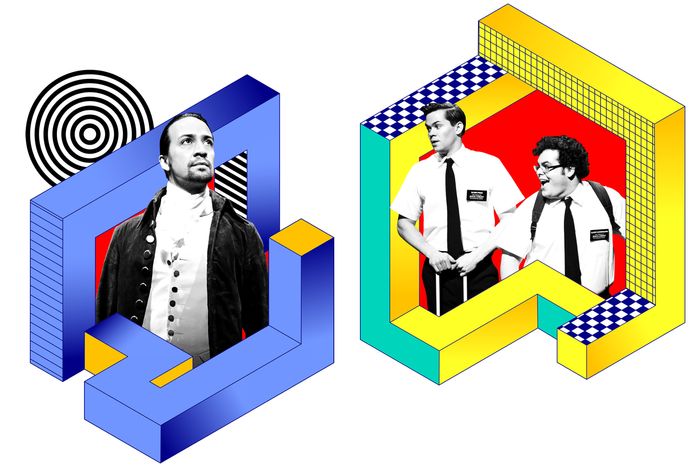
Every decade gets at least one Broadway juggernaut. In the theater in the 2010s (the century’s teens, classic time of rebellion and learning how much damage we can do), we had two. In 2011, The Book of Mormon roared into town to universal acclaim, immense box office, and — crucially — stamina. This thing had legs, it had guts, it had the tourist market by the short hairs. And then, of course, came Hamilton. It started Off Broadway at the Public Theater in 2015, transferred uptown that summer, and made the world fall to its knees. Again: rapturous reviews, think pieces in every publication in town (including this one, for a nonstop week in 2016 and many posts before and after), the rocketship ascent of Lin-Manuel Miranda. These two shows couldn’t be more different, so what does it say about this decade that they have been the twin suns of commercial theater in the United States?
First, nothing sells like irreverence coupled with actual facts. Both shows, singable as hell, make their audiences feel clever; both are educational about a key American institution. When you leave either musical, you’re full to bursting with new things you can talk “knowledgeably” about at parties, like who the angel Moroni is, or what the deal was with Hercules Mulligan. Americans love instruction. And also, we have a deep need to see young men horsing around. I went to both productions when they opened, and let me be clear — I loved them. I laughed like a nut at The Book of Mormon, and I thought it had a brave take on the value of religion. I had only one bad association with my beloved Hamilton, which is that I stepped on Meryl Streep’s foot while walking to my seat, and even that … is kind of a flex. But surely Obama-era musical theater must seem like Renaissance drama now: Only in a time of spiritual superflux could something so expansive exist. And so in a desperate move to reconnect to my happiest self (sitting in a dark theater before 2016), I went back to both.
The easier one to get into was The Book of Mormon. I bought a ticket on StubHub at the last minute — in the orchestra, even. I did an unscientific survey of the Sunday-afternoon audience, and it looked almost entirely white and middle-aged. (I am also white and middle-aged, so I melted right in.) In case you can’t — haha — remember 2011, The Book of Mormon tells the story of Elder Price, a seemingly perfect young man who gets teamed up with the dorky and clingy Elder Cunningham for their mission assignment — an odd couple that proselytizes together. They practice ringing doorbells (the bravura introductory song “Hello”) to share the beliefs of the Latter Day Saints, but when they get shipped to Uganda, they find that they’re extremely unprepared for the (a) local warlord, (b) local indifference, and (c) local AIDS epidemic.
Until the plane lands, the show is still hilarious. I saw a stand-in for Elder Price — the gifted Bud Weber — and perhaps due to having someone new onstage, the cast seemed pleasantly surprised by one another. There were glints in the eyes, stifled giggles, a general air of slightly rambunctious bonhomie. The actors in the pre-Uganda portion are young white men, all triple threats, all as precise as military cadets. Their “Hello” brought the house down; it’s one of the great scene-setting songs, and even after eight years, it’s enough to hang a show on.
But let’s be honest. The story — created by Matt Stone and Trey Parker, the naughty brains of South Park, and Robert Lopez, who wrote Avenue Q — has not aged well. The sequences in Uganda are grimly unfunny, especially as black actors are forced to sell jokes about curing AIDS by sodomizing babies. The romantic interest Nabulungi (Kim Exum) is the brightest girl in the village, and she thinks that “texting” means typing on a broken typewriter. That’s not a joke about poverty or disenfranchisement. That’s a joke about an African woman being an idiot. In 2011, some critics called the show out for its painful racism, but not many. The assumption was that the offended parties would be Mormons, who might be stung by the quasi-diorama-style retellings of the Mormon founding myths, for instance, or the song “Spooky Mormon Hell Dream.” (Mormons don’t actually obsess about hell, but whatever.) Some, assuredly, were. Yet the show is at its heart sympathetic to them: Mormons are shown as individuals with a passion for pastoral care, and even the burlesque treatment affords them a huge generosity of spirit. Mormons do well out of this thing, whereas Ugandans should have, I don’t know, sued.
In the case of The Book of Mormon, the show didn’t change — I did. When it comes to the actual production, it doesn’t show its years at all. As is true among Mormon missionaries, there seems to be a never-ending supply of young, beautiful, talented people who can sing these songs well. Lopez, Stone, and Parker wrote for the sweet spot of the musical-theater voice, and every training program in the country is churning out singers who can deliver ’em right to the second balcony. The bench for this sort of part is so deep that I saw an understudy in the show’s thousandth cast, and he gave the purest, most bell-like musical theater performance I heard this year.
Which brings me to Hamilton.
I … know this is going to get me canceled. But that juggernaut has mud in its wheels too. Some of it is the inevitable disappointment that goes with the anticipation that Hamilton still sustains. I was given a pair of press seats, and I held those things as reverently as golden Wonka tickets. I hoped I’d have the experience I’d had at the Public and later uptown, back when the world was new, which of course was impossible. But I also brought a breathless and eager rookie — and it turned out that both of us were slightly sad about the way the show sounded. It’s the devil’s duo: We come in with sky-high expectations and many of us now know the cast album by heart. (Every time I connect my phone in a rental car, it automatically plays that confiding whisper “1776 …”)
Miranda was writing for particular voices, with specific gifts. For example, he posed insane challenges to the show’s original Marquis de Lafayette, Daveed Diggs, issuing him Autobahn-speed raps that needed to be delivered in a heavy French accent. What musical-theater program is teaching anyone how to do that? Again, I saw a fill-in (it’s understudy-palooza out there in the long-running shows), and he struggled mightily till he found his feet in the less taxing second act. The development of Hamilton was unconventional, with freestyle friends of Miranda’s filling crucial roles. It brought a new sound and rhythm and set of influences into the old way; it rewarded vocal superheroes like Renée Elise Goldsberry who could shift between forms, and it flattered those (like Miranda himself) whose legit voices were not monumental. Now that Hamilton is plugged firmly into the conventional Broadway socket, with casting agents going through their customary stacks of musical-theater résumés, unsuited voices are showing up to play.
It’s instructive to see where new casting has served the show. When I saw it, Daniel Breaker was playing Burr, and though he doesn’t have Leslie Odom Jr.’s nectar-and-ambrosia sound, he does bring a lovely weariness to the part — a kind of damping, side-eyeing, straight-man vibe. You can’t picture this Burr raising an army to overthrow the United States on the border (facts!) because he clearly just needs a calm drink. This teases out an aspect of the show that hadn’t been as clear before, namely, the drudgery of survival. Odom’s Burr was apparently the same age as Miranda’s Hamilton; Breaker’s Burr seems clearly older. Someone must “live to tell your story” all right, but Breaker lets us see the cost of that living.
And what about the musical itself? How does it read in 2019? Well, King George is still the funniest bit, and he kills on every line. The decline in firework charisma in the cast means that it’s now clear that the second half is a little wander-y; it’s difficult to transition from the stakes of founding a country to Hamilton’s personal beefs and missteps. A primary message of the actual script has to do with empowerment-through-effort (there are big swells of emotion whenever we register the sheer quantity of Hamilton’s output), which connects to the show’s practical moral: Making history is inextricable from writing history. You must write — not just talk, write — to control your destiny and protect your legacy. That command still stands, and it hasn’t been affected by the passing years.
But when we rhapsodize about Hamilton, we’re usually discussing the core conceptual subversion: Black and brown actors embodying the triumphal national narrative. And there the tides seem to run in two directions at once. Yes, it’s still exciting to see. But also? After the show opened, we all became baby experts on these guys. If any of us hadn’t then faced the fact that Washington and Madison, conflicted as they were, bought and sold human beings, we certainly must now. (If you don’t know, now you know.) Rather than being honestly evaluated, the Founding Fathers are being forgiven, even lionized for abolitionist beliefs they often didn’t have. That smears a little dirt on the merriment, even though Miranda’s songs — dense, brilliant surprises even after hundreds of listens — still crackle. The show that director Thomas Kail built zips along on polished rails, a wonderful machine. But there’s a little hollowness there, if I’m hearing the room and my own mind right.
Because Hamilton wasn’t just a musical. It was a corrective, a cannonball, a call to work (Work!), a promise. Obviously, tickets to it haven’t ever been cheap, but it still managed to find its way to the young, scrappy, and hungry who needed to hear it. The orchestra section is now, seemingly, just expense accounts and millionaires and one-show-in-my-lifetime splurgers. Lines like “Immigrants — they get the job done!” now receive wild applause only from a very specific section of the theater, basically the lottery seats. There’s less of the collaborative, 360-degree excitement that characterized it a few years ago, and less of the sense that the audience is pouring energy back onto the stage as fast as the cast can ladle it out. “Here we are in the resistance together” has become “Entertain us,” which is, considering the respective racial makeups of the audience and cast, troubling. (The mainstream’s best trick is that it commodifies even the things that critique it.) And, to quote a different Broadway show, it sometimes feels like we’re seeing people waving through a window. Remember 2015? The poster of the presidents finally had a black face on it, and we looked at Hamilton as though it was telling us our future as well as our past. This is how things will look from now on, it said. Then we threw away our shot.
The Book of Mormon is at the Eugene O’Neill Theatre.
Hamilton is at the Richard Rodgers Theatre.
*A version of this article appears in the January 6, 2020, issue of New York Magazine. Subscribe Now!


